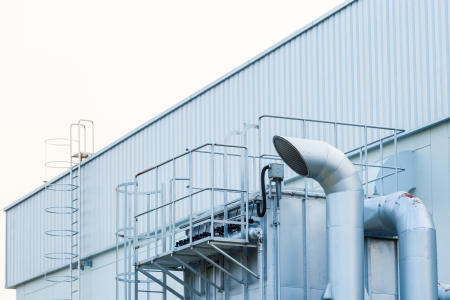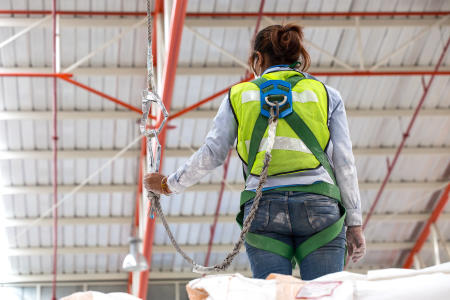What’s the Difference Between Passive & Active Fall Protection?
Employees falling is the number one cause of fatal construction injuries. It’s no surprise, then, that fall protection citations are the most common violations of OSHA safety standards. In order to maintain a safe and compliant workplace, employers need to understand and properly implement fall protection measures. It’s therefore important to identify the differences between passive fall protection and active fall protection and know how to determine which system best addresses the fall hazards in your work environment.
Passive Fall Protection: Preventing Falls
 Once
installed,
a
passive
fall
protection
system
is
stationary
and
non-dynamic,
meaning
that
it
doesn’t
move,
adapt,
or
change
when
in
or
out
of
use.
No
human
interaction
is
required
for
the
system
to
serve
its
purpose
of
preventing
a
fall.
As
a
result,
workers
don’t
need
to
wear
additional
fall
protection
equipment
in
order
to
stay
safe.
Common
types
of
passive
fall
protection
systems
include:
Once
installed,
a
passive
fall
protection
system
is
stationary
and
non-dynamic,
meaning
that
it
doesn’t
move,
adapt,
or
change
when
in
or
out
of
use.
No
human
interaction
is
required
for
the
system
to
serve
its
purpose
of
preventing
a
fall.
As
a
result,
workers
don’t
need
to
wear
additional
fall
protection
equipment
in
order
to
stay
safe.
Common
types
of
passive
fall
protection
systems
include:
- Aerial lifts and platforms
- Handrails and guardrails
- Safety netting
- Barricades
- Scaffolding
ADVANTAGES OF PASSIVE FALL PROTECTION
Simplicity:
Passive
fall
protection
systems
are
easy
to
install
and
maintain.
No
training
needed:
Since
passive
fall
protection
systems
are
always
in
place
and
don’t
require
any
worker
engagement,
there’s
a
significantly
lower
risk
of
user
error.
You
don’t
need
to
be
trained
on
how
to
use
guardrails
or
safety
netting
in
order
to
benefit
from
them.
Fall
prevention:
It’s
much
safer
to
prevent
a
fall
as
opposed
to
minimizing
the
effects
of
a
fall
that’s
already
occurred.
DISADVANTAGES OF PASSIVE FALL PROTECTION
Impractical
for
some
applications:
Passive
fall
protection
is
ideal
for
architectural
designs
and
stable
work
environments,
such
as
a
non-penetrating
railing
system
on
a
roof.
If
a
work
area
is
constantly
changing,
then
installing
a
passive
system
may
not
be
practical
or
cost-effective.
Limits
access
to
work
site:
Some
passive
fall
protection
systems,
such
as
guardrails,
can
prevent
workers
from
performing
necessary
tasks
in
hard-to-reach
places.
Active Fall Protection: Stopping Falls
 Active
fall
protection
systems
can
be
implemented
when
passive
fall
protection
isn’t
feasible.
They
are
dynamic,
contain
moving
parts,
and
require
human
interaction.
In
order
for
an
active
system
to
keep
workers
safe,
they
must
wear
the
appropriate
personal
protective
equipment
(PPE).
An
active
fall
protection
system
includes
the
following
movable
components:
Active
fall
protection
systems
can
be
implemented
when
passive
fall
protection
isn’t
feasible.
They
are
dynamic,
contain
moving
parts,
and
require
human
interaction.
In
order
for
an
active
system
to
keep
workers
safe,
they
must
wear
the
appropriate
personal
protective
equipment
(PPE).
An
active
fall
protection
system
includes
the
following
movable
components:
- Overhead rigid rail
- Anchorage points
- Full-body harness
- Lifelines and lanyards (self-retracting and shock-absorbing)
- Connectors (snap hooks and carabiners)
- Deceleration devices
Types of active fall protection systems include work positioning systems, vertical fall protection systems, and horizontal fall protection systems. Read our blog to learn more about the types of active fall protection.
Personal Fall Restraint vs. Personal Fall Arrest
There are two subcategories of active fall protection: fall restraint and fall arrest systems. A personal fall restraint system restrains a worker from reaching a fall hazard leading edge. A short, fixed-length lanyard is attached to the worker’s body harness to prevent him from getting too close to the edge of a roof or from falling out of an aerial lift basket, for example. This method of active fall protection is preferred because it is a preventive measure.
A personal fall arrest system incorporates four critical components—anchorage, full-body harness, lanyard, and connectors—to safely decelerate and halt a free-falling worker before he impacts a surface below. This active fall protection system is required on construction sites where workers are exposed to vertical drops of 6 feet or more. Employers should inform their workers about how the fall arrest equipment will affect their bodies if triggered by a fall and have a retrieval system in place for emergency rescue should a fall occur.
ADVANTAGES OF ACTIVE FALL PROTECTION
Flexible
applications:
Since
active
fall
protection
systems
are
adaptable,
they
can
be
implemented
in
a
variety
of
industrial
and
construction
settings
with
ease.
Allows
greater
access
to
work
site:
Workers
can
safely
navigate
more
dangerous
or
hazardous
areas
of
a
work
site
while
wearing
active
fall
protection
equipment.
DISADVANTAGES OF ACTIVE FALL PROTECTION
Requires
training:
In
order
for
active
fall
protection
to
adequately
protect
workers,
they
must
understand
how
to
use
the
equipment
properly.
For
instance,
workers
need
to
know
how
to
wear
their
harness
the
right
way
and
to
which
anchorage
point
it
should
be
attached.
Using
active
fall
protection
improperly
increases
the
risk
of
injury.
Equipment
must
pass
regular
inspections:
Active
fall
protection
system
components
must
be
structurally
sound
at
all
times
to
ensure
worker
safety.
The
equipment
must
be
up-to-date
with
OSHA
standards
and
be
free
of
visible
damage
such
as
tears
or
cracks
in
order
to
pass
safety
inspections.
Choose Americrane and Hoist Corp. for Reliable Fall Protection Equipment
Americrane and Hoist Corp. is your number one choice for fall protection equipment. The Elk River brand adjustable harnesses offer custom-fit comfort without sacrificing safety. You can also choose from several energy-absorbing lanyards, self-retracting lifelines, and anchorage connectors. Each of the products we stock is built with the highest quality of craftsmanship, a testament to our keen focus on worker safety. Contact us today for more information on our selection of fall protection equipment products.
Contact Us | Hoists | Hoist Parts | Cranes | Beam Clamps | Inspections & Training | About Us | Customer Reviews | Privacy Policy | Shipping & Returns
Americrane & Hoist Corporation | 13311 Enterprise Ave | Cleveland, Ohio 44135 | Phone: 216-267-9100 | Fax: 216-267-9131
All Rights Reserved 2026, Americrane & Hoist Corporation
Admin Login | Web Site Developed by Alt Media Studios







